On Friday, April 13, 1945, the destroyer Laffey sailed 20 miles west from Okinawa to Kerama Retto, a mountainous island cluster that was home to Wiseman’s Cove, a repair anchorage.
Sailors on board the battered ships there called it the “Bone Yard.” Among the anchored vessels, the Laffey’s unscarred metal, trim lines, and clear decks set the 2,200-ton Allen M. Sumner-class destroyer apart, as did its size and firepower.
In addition to six five-inch cannons, the 376-foot ship, which had come to prepare for a perilous assignment, boasted nearly two dozen 40mm and 20mm antiaircraft guns.
The navy had commissioned the Laffey in February 1944 to replace a namesake lost off Guadalcanal in November 1942.
Cmdr. Julian Becton, 36, and a core group of veteran officers and petty officers had overseen the commissioning, then trained a 336-man crew, mostly raw recruits. From the bridge of another ship, Becton had seen the first Laffey go down. When he learned he would be commanding the new Laffey, he resolved to avoid its predecessor’s fate.
After shakedown, the Laffey crossed the Atlantic to participate in the Normandy invasion.
Off Utah Beach on June 6,1944, the destroyer escorted amphibious craft to the beach, then screened larger ships bombarding the shore.
The crew first saw fighting action on June 8, 1944, but the Laffey’s real baptism by fire occurred on June 25 off Cherbourg.
When German coastal batteries threatened Allied minesweepers, destroyers Barton, O’Brien, and Laffey rushed in to lay smoke. The Barton and the O’Brien took direct hits. Another German shell landed off the Laffey’s port bow with a huge splash; afterward, damage control personnel discovered an unexploded round on the deck of the boatswain’s locker, a cramped bow space just above the waterline.
They hoisted the yard-long, 400-pound projectile through hatches to the main deck and rolled it overboard. Fortunately, the Channel was calm — no swells to flood the bow or trigger a blast.
A month later, the Laffey recrossed the Atlantic to have repair, maintenance, and modifications done at the Boston Navy Yard.
The destroyer seemed a lucky ship — but the true test of that reputation waited on the far side of the world.
After undergoing modifications, the Laffey in late October steamed for the Pacific, reaching the Philippines and Task Force 38 to prepare for screening the invasion of the islands.
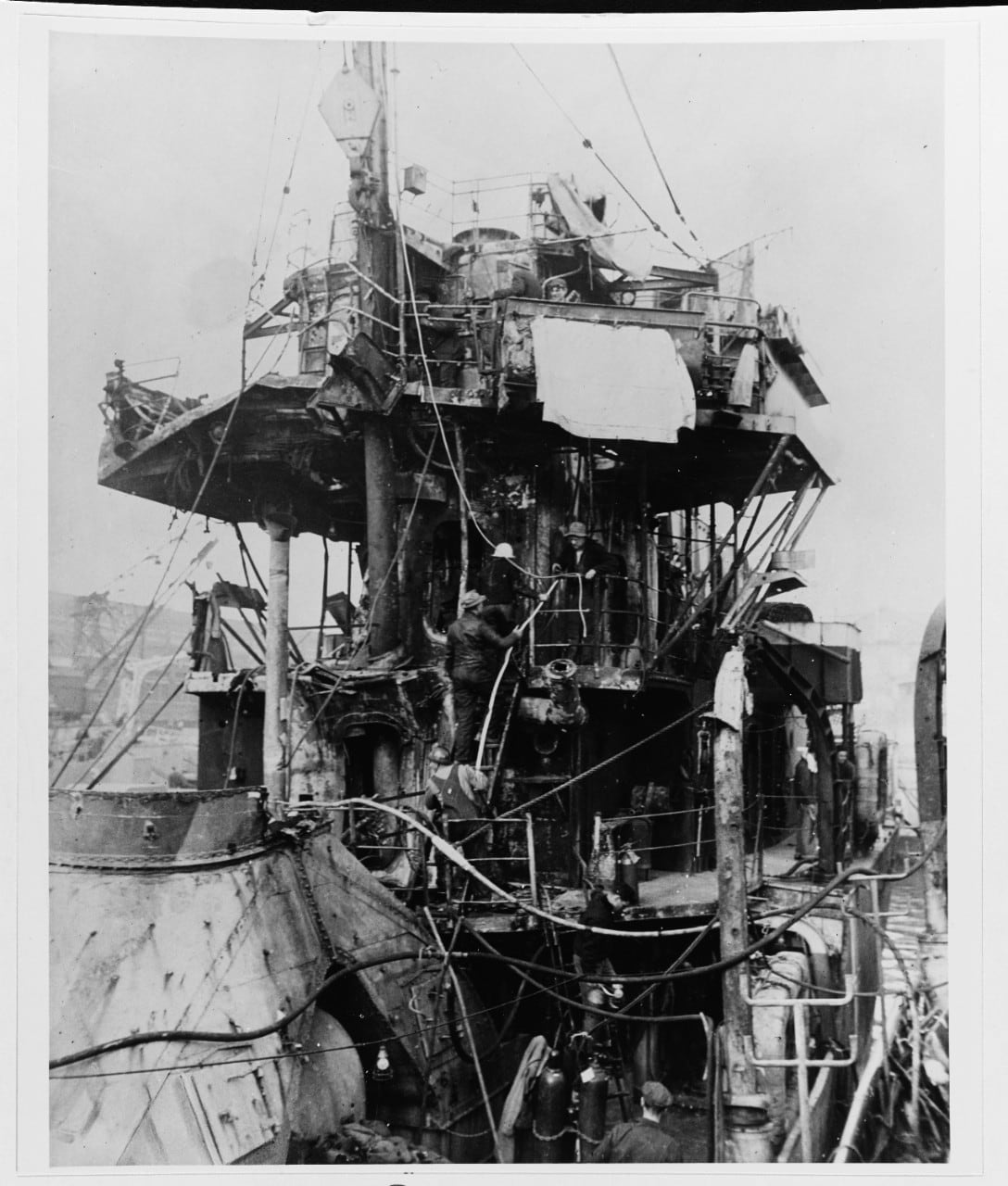
Taking inspiration from a legendary “Divine Wind” said to have protected ancient Japan from an attacking Mongol fleet, Japan’s warlords fashioned a modern intervention: aerial suicide crashes aimed at sinking enemy ships — especially aircraft carriers. Multiplied many times, these tactics might prevent Japan’s utter defeat.
The Allies attributed the initial sporadic suicide flights to crazy individual pilots. But in December 1944, as the Allies began a series of Philippine island invasions, suicide attacks increased in frequency and ferocity.
During the Dec. 7 assault on Ormoc, a city on the Leyte coast, Becton and crew watched a pilot deliberately dive to sink a transport. A destroyer intentionally struck by another enemy pilot had to be scuttled, and similar attacks damaged two more destroyers.
On Dec. 10, when Japanese pilots slammed into five vessels, the Laffey stood by the destroyer Hughes to assist with damage control and tend to wounded men, many of them grievously burned.
The harrowing pattern reached a crescendo on Jan. 6, 1945, off Luzon. Suicide pilots there mauled 11 ships, but the Laffey again escaped unscathed.
By February, after maintenance at Ulithi, the Laffey had joined a fast carrier task force supporting the invasion of Iwo Jima.
To provide early warnings of enemy aircraft, the Navy had developed new tactics: a mobile picket line of destroyers deployed 50 miles ahead of the fleet. Some pickets carried fighter-director teams — radar and tactical communications specialists — that controlled Combat Air Patrol fighter aircraft.
The Iwo Jima campaign proved uneventful for the Laffey, as horrid weather staved off any airborne threat.
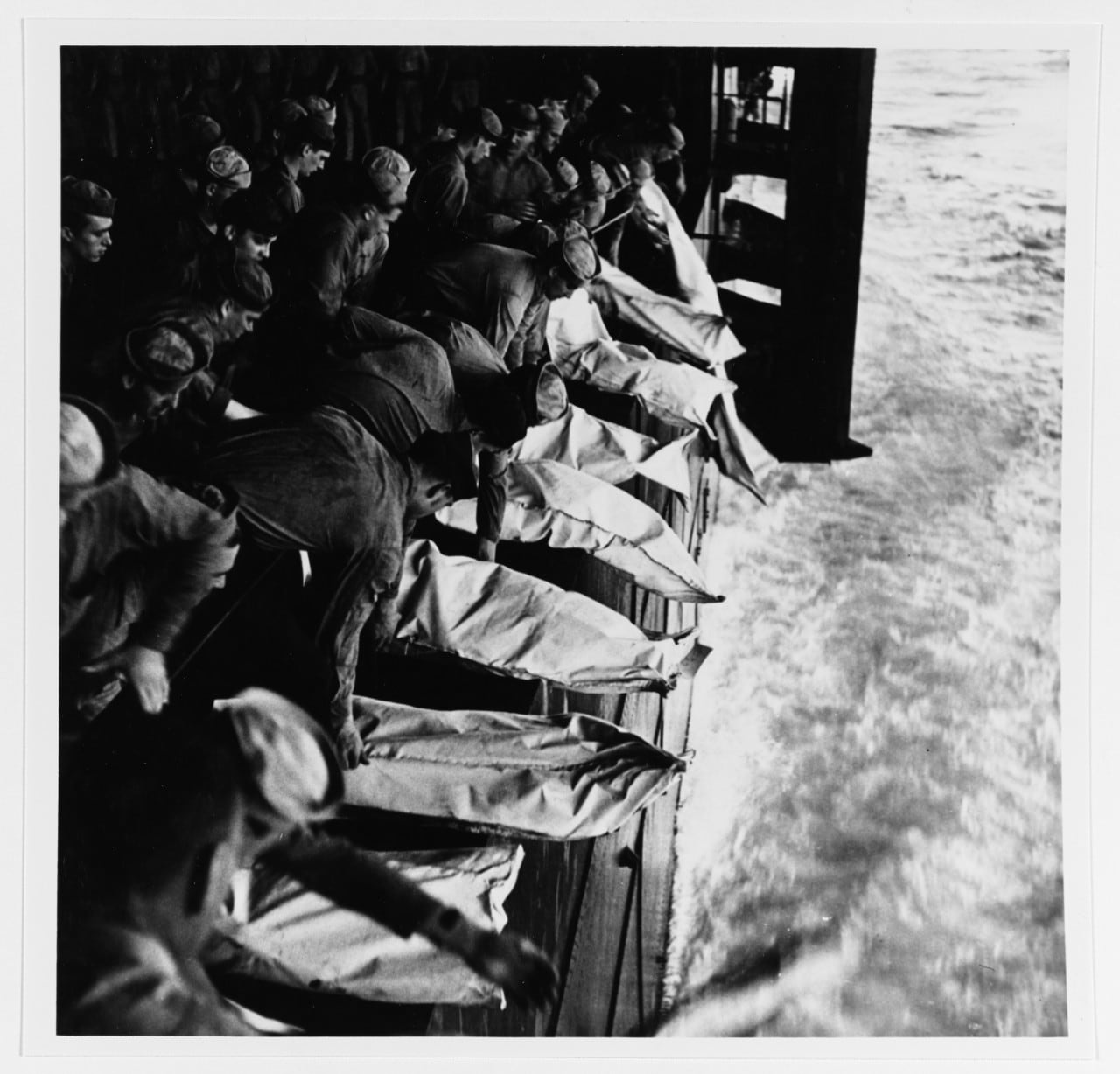
Next up for the destroyer, however, was duty in the Combined Joint Expeditionary Force invading Okinawa, an island well within the range of planes based on Japan’s home islands.
To shield the Okinawa landings, a necklace of 15 fixed radar picket (RP) stations encircled the island.
RP 1, the station nearest Japan, lay 50 miles due north of “Point Bolo,” the westernmost spot along Okinawa’s central coast. The other pickets, numbered clockwise, also took bearings from Point Bolo.
Each picket ship was to patrol its station for several days — unless damaged or sunk.
The RP necklace was not the only cordon; a 39-station interior “ping line” of smaller screening vessels guarded the invasion fleet against submarines and lesser surface craft.
But it was RP 1 and adjacent posts that would encounter the main aerial threat.
The landings began on April 1, 1945.
From then through April 12, as the Laffey’s crew was enjoying comparative safety screening offshore bombardment ships, nearly 50 American vessels, including 30 picket or ping-line destroyers, took aerial hits.
Twenty-four, including 15 destroyers, were sunk or scuttled. Casualties reached nearly 1,000 killed and 1,500 wounded, for a time dwarfing the toll ashore.
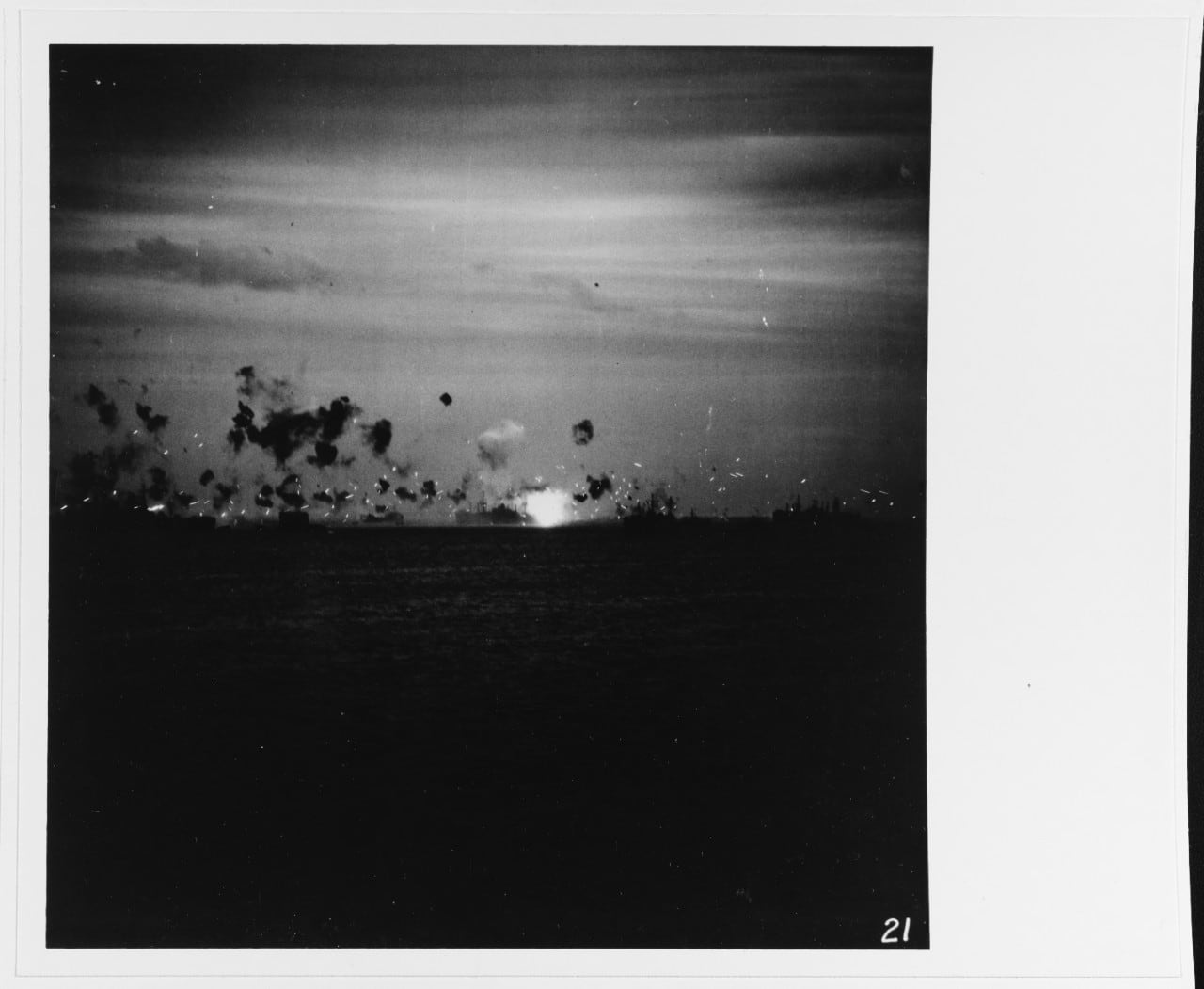
Japan’s aerial strategy, called Operation Ten-Go, combined massed attacks by conventional bombers and suicide aircraft called “floating chrysanthemums.”
On April 6 and 7, for example, 700 planes, roughly half on suicide missions, swarmed American ships, sinking five and damaging 15. As blasted vessels reached Wiseman’s Cove, the Bone Yard became an even ghastlier sight.
The Laffey’s April 13 stay in Wiseman’s Cove was brief. After refueling, rearming, loading the first mail received in seven weeks, and boarding a five-man fighter- director team, the ship set sail for RP 1.
Reaching station the next day, the Laffey was joined by two Landing Craft, Support, LCS-51 and LCS-116.
LCSs were adaptations of Landing Craft, Infantry, heavily armed with .50-caliber, 20mm, and 40mm guns. Slow — top speed 16 knots — shallow-bottomed, and squat — 160 feet long, with a 23-foot beam — the ungainly LCS’s chief merit was versatility.
Two high-capacity pumps enabled the gunboat to double as a fireboat. Young LCS skippers like the 51’s Lt. Howell D. Chickering and the 116’s Lt. A. J. Wierzbicki had few illusions about their purpose. After suicide attacks they would be dousing fires, moving casualties, and recovering survivors.
Turning over RP 1 to the Laffey on April 14, the departing destroyer’s commanding officer reported few enemy “snoopers” aloft, and no raids.
Conditions remained quiet until Sunday night, when all at once snoopers seemed to fill the sky. Combat Air Patrol fliers squelched the threat, but unease remained.
When general quarters ended at 3 a.m., bridge quartermaster Aristides “Ari” Phoutrides, 19, crawled exhausted into his rack. Phoutrides, son of a Greek Orthodox pastor in Seattle, felt sure that the Laffey was about to catch hell.
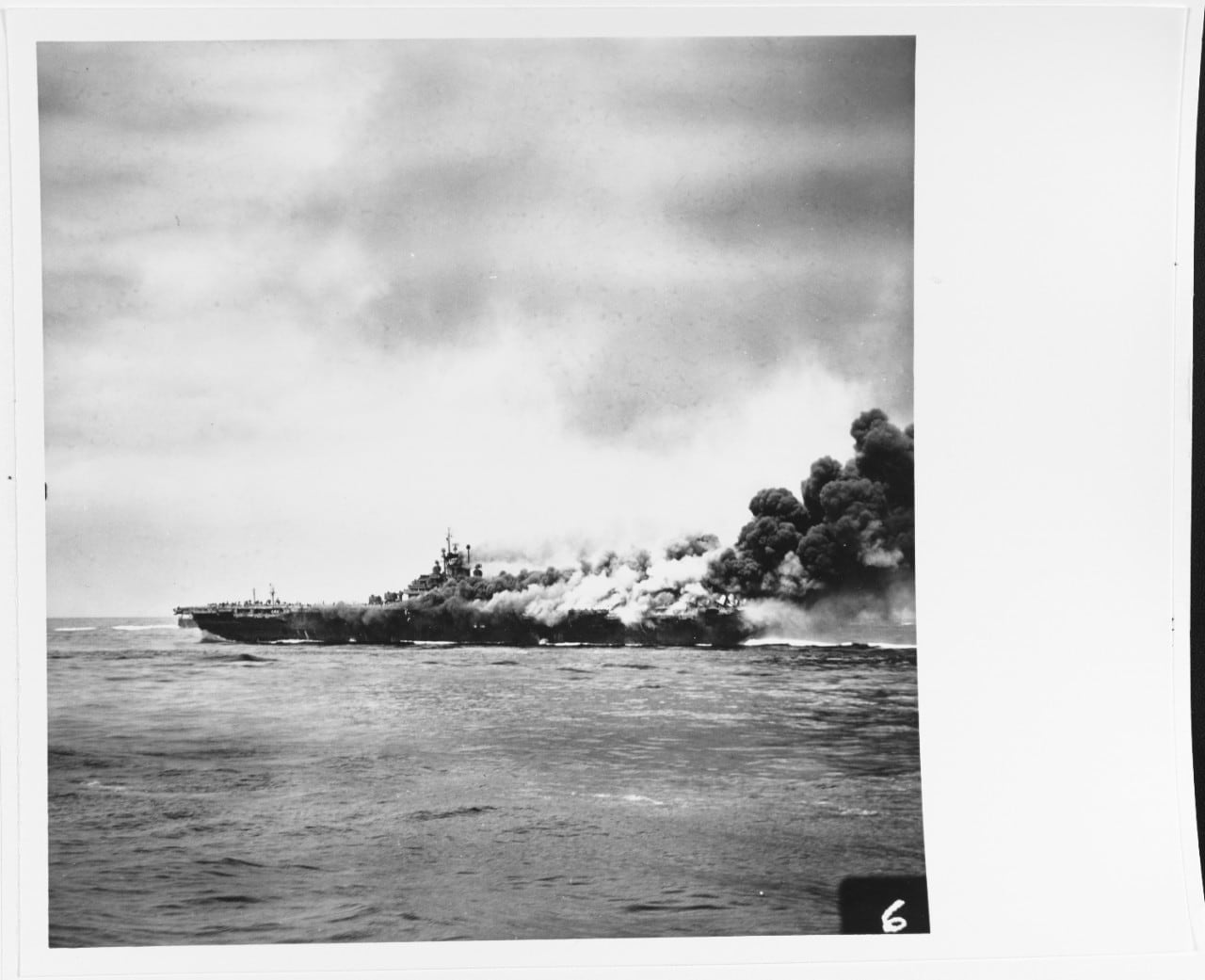
Monday dawned quiet.
The Laffey’s breakfast chow line stretched to the main deck when radar operators picked up a single enemy aerial contact or “bogey” — an Aichi D3A “Val” dive-bomber, recognizable by its fixed landing gear — off the port bow.
The crew raced to general quarters and the five-inch gunners in forward mounts 51 and 52 opened fire.
The Val retreated, but crewmen stayed at battle stations; within 45 minutes, radar detected many more bogies.
Combat Information Center officer Lloyd Hull, 22, sensed a nightmare unfolding. Soon lookouts topside spotted Vals, “Judys” — Yokosuka D4Y dive-bombers — “Kates” — Nakajima B5N torpedo bombers — and “Oscars” — Nakajima Ki-43 fighters — poised to attack the Laffey.
Four Vals peeled off — two of the pilots aiming for the starboard bow, two for the stern.
“Here they come!” shouted Seaman Ramon Pressburger, 21, a loader on a starboard 40mm. “Here they come!”
Cmdr. Becton, shouting orders from the flying bridge by voice tube to quartermaster Jack Doran in the pilothouse below, ordered hard left rudder; he meant to stay broadside to the attackers so as many guns as possible could engage.
In the gunfire director, or “basket,” atop the flying bridge, gun boss Paul Smith had permission to fire when ready.
Under director control, mounts 51 and 52 downed the two Vals off the bow. Flying low, one Val bound for the stern caught a wheel on a wave and nosed in. Cannon blasts from mount 53, abetted by the ship’s 20mms and 40mms and those aboard the LCS-51, brought down the other attacking Val.
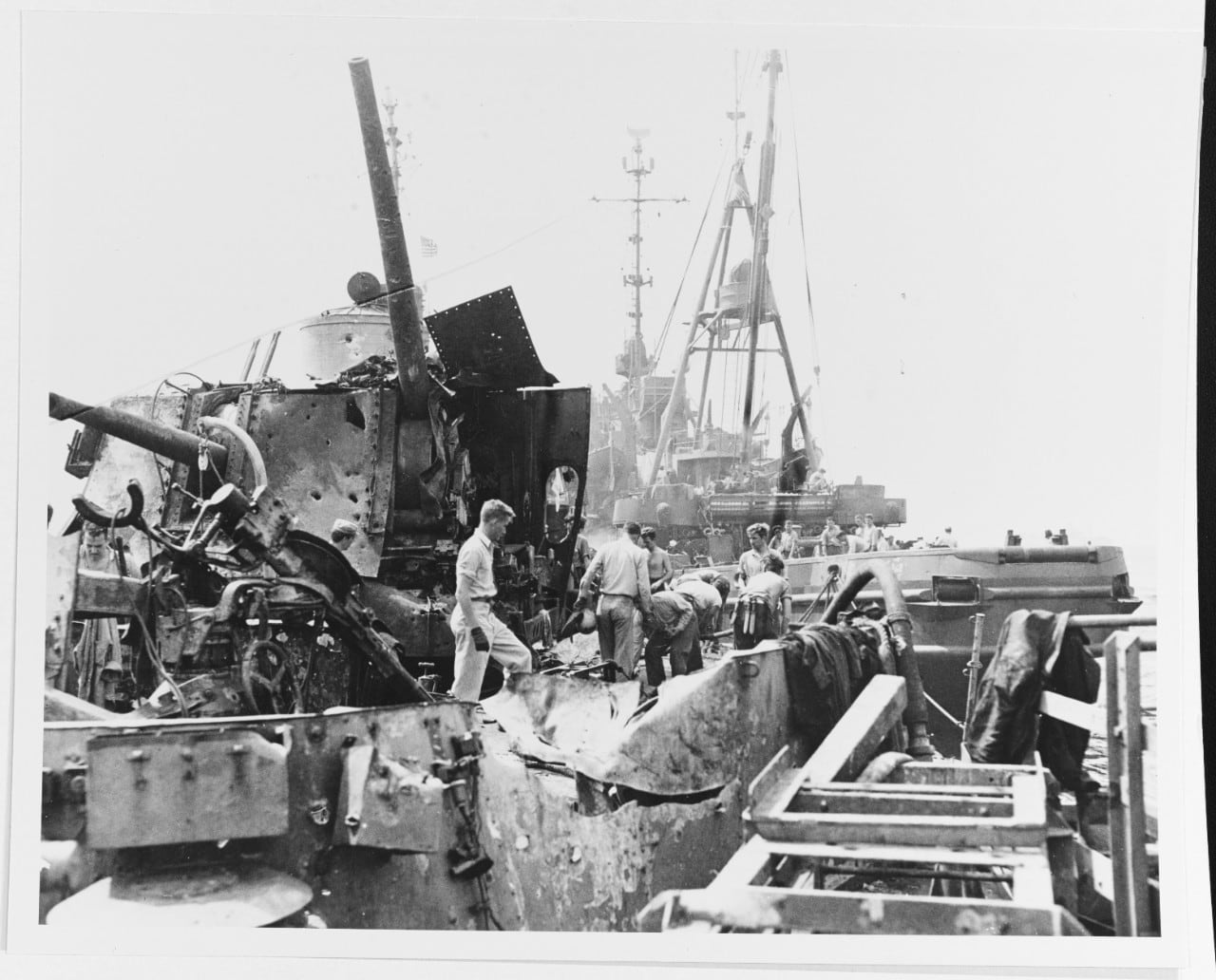
Next came two Judys. The first, angling for the starboard beam, came in low, a bull’s-eye for the Laffey’s 20mms and 40mms.
With the other Judy aiming for the port beam, Becton ordered helmsman Doran to swing 30 degrees to starboard. The port 20mm and 40mm gunners splashed that Judy, but not before its pilot dropped a bomb that exploded directly alongside. Shrapnel peppered portside 20mm gunner Bob Robertson, 19, who would lose an eye but survive because gun captain Fred Burgess shoved Robertson to the deck as the blast nearly severed one of Burgess’s legs below the knee.
As crewmates replaced incapacitated gunners, the morning’s seventh and eighth attackers moved in: a Val to port and a Judy to starboard.
Laffey gunners hammered the Val, but its pilot maintained a shallow dive toward mount 53, where mount captain Lawrence “Ski” Delewski, 20, had just had a cannon misfire. The Pennsylvanian deftly stepped down from the topside hatch and into the armored gun house, where he hammered the gun’s breech with a rawhide-covered maul. As the balky gun barked, the oncoming Val grazed the spot where Delewski had just been standing and skidded into the water.
The starboard Judy never got close; 20mm and 40mm fire left its death-wish pilot without a plane to fly.
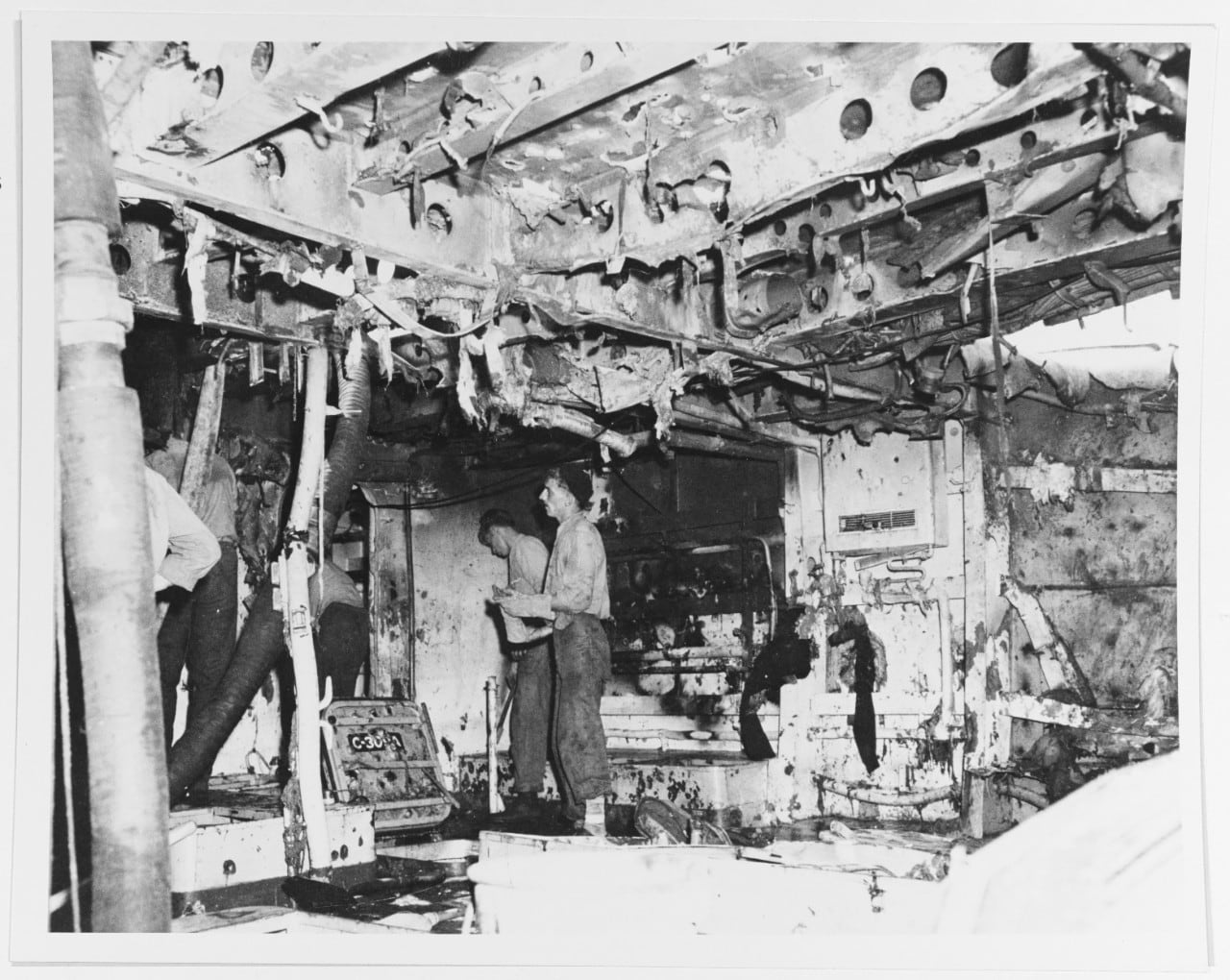
It was 8:42 a.m.
On the bridge, Ari Phoutrides had recorded eight planes and eight kills in the log. Everyone on board, especially the gunners, had held his own in the siege, now in its 12th minute. Seconds after Becton returned to the pilothouse from the flying bridge, the first plane that would hit the Laffey squarely, a Val, aimed for the port beam.
As the dive-bomber’s lacerated wing tanks dripped fuel, its pilot banked between the destroyer’s stacks. The Val’s landing gear obliterated the starboard side 20mm mounts and two sets of 40mms; it lost a wing, then toppled over the side.
Three gunners died outright; a fourth, soaked in fuel and afire, leaped overboard.
Fires topside plumed black smoke. Exploding 40mm clips perforated the deck, allowing flaming gas to stream into a magazine.
In the engineering spaces, smoke forced men to close ventilators. Blistering temperatures soared higher. Communications circuits began to falter, prompting Lt. Al Henke, the Laffey’s engineering officer, to improvise.
He told throttlemen that if communications failed — as they soon would — they should keep pace with the rate of the ship’s gunfire.
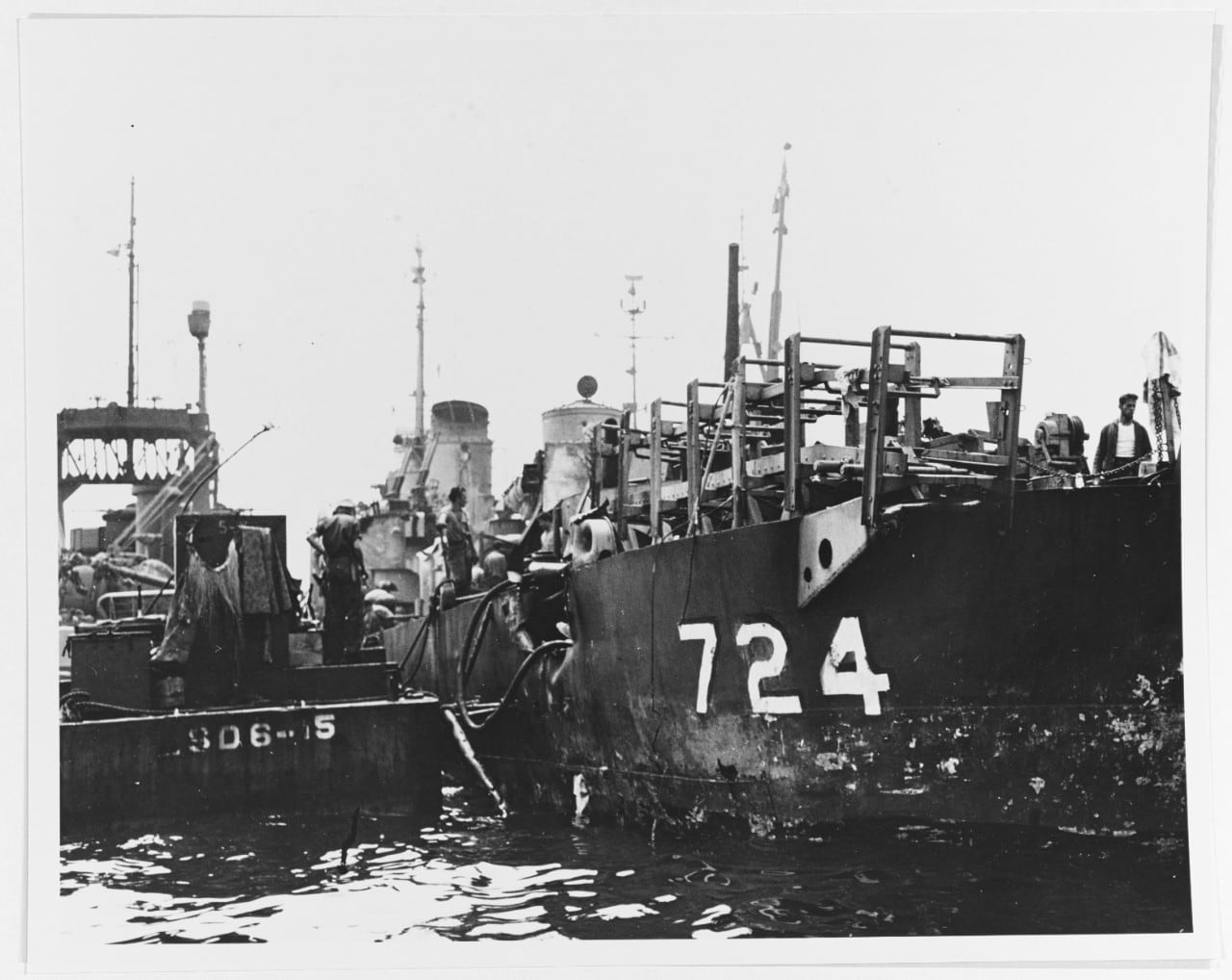
In the darkened Combat Information Center below the pilothouse, Hull’s radar team could not see but keenly felt the violence. Luminous dots — most now too near to distinguish, track, or report — pocked their screens. The communications officers were on the horn with the amphibious command ship Eldorado. Combat Air Patrols were changing shifts, delaying fighters.
“They’ll come, Captain,” executive officer Lt. Challen McCune, a 26-year-old Iowan, assured Becton. “We’ll have to hold the bastards off for awhile ourselves.”
Hoping to contain the flames, Becton slowed the Laffey.
“This marked us as a cripple,” he recalled. “The Japs really went to work on us.”
Three new attackers approached astern.
“Ski” Delewski, now captaining mount 53 from a side hatch, spotted the first, a Val, to starboard. Only the three fantail 20mms had a clear shot. The gunners zeroed in, but momentum carried the Val into the fantail, scraping away the 20mm mounts, killing six men and bulldozing Delewski’s mount.
The plane’s bomb exploded, disintegrating the aircraft, shearing away gun house armor plate, tearing holes in the main deck, and igniting fires that threatened the after magazine.
The blast threw Delewski 15 feet onto the portside main deck, remarkably unharmed.
Becton ordered the after magazine flooded. No sooner was this done than a Val or a Judy — no one was sure which — crashed into the ruins of Delewski’s mount.
Both plane and bomb blew, killing six of Delewski’s crew and skewing a gun barrel skyward like a dislocated finger. The impact and explosion stove in the starboard quarter, exposing interior spaces.
With the Laffey defenseless astern, a Val pilot planted a bomb on the fantail. The blast severed the rudder cables and hydraulics.
“Captain, rudder jammed at 26 degrees left,” Doran shouted through the tube to the beleaguered Becton.
Throughout, LCS-51’s Howell Chickering had managed to stay close to the Laffey. When attacks got heaviest, several 51 sailors panicked and jumped overboard.
“If you stop to get them,” a chief petty officer warned his skipper, “I’m jumping off, too!”
Chickering kept going.
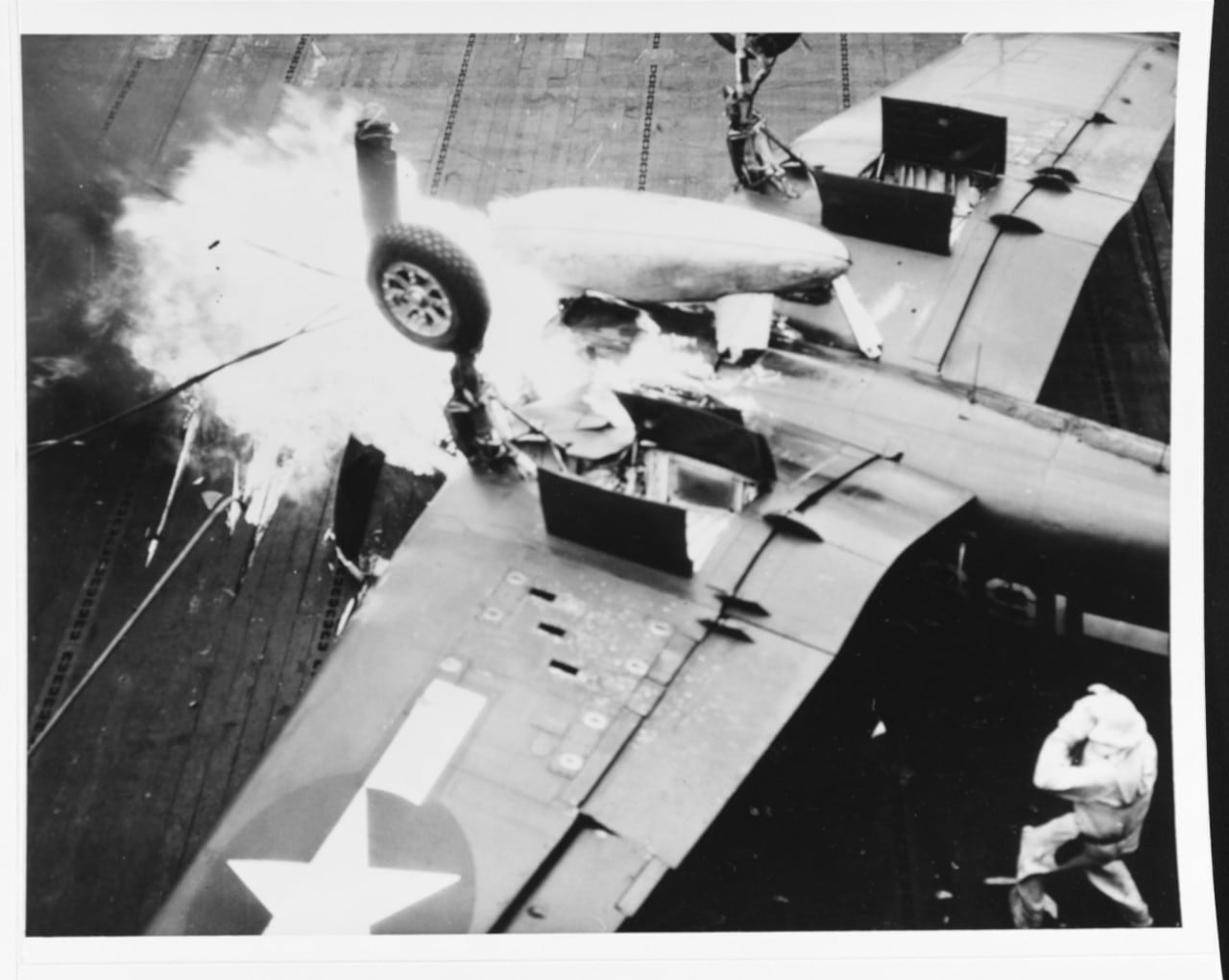
Aboard LCS-116, now well off to the east and out of range of the Laffey and the 51, men had their hands just as full. Ray Davis, a forward 40mm gunner, had locked onto a Japanese aircraft when a Corsair swooped in to shoot it down.
Cheers went up — perhaps the worst was over.
But just then a bomb-carrying suicide plane struck the 116’s after 40mm gun, killing three crewmen and wounding others. As tumbling ammunition clips exploded above Davis and his crew, a second enemy flier zoomed in.
Davis’s 40mm couldn’t swing far enough to reach the plane, but an alert .50-caliber gunner stitched rounds right into the cockpit. The pilot slumped and his plane’s nose jerked up.
The aircraft cleared the 116, barrel-rolled into the water, and exploded.
Even as inbound Combat Air Patrol pilots reached LCS-116, two more suicide planes struck the Laffey, each slamming into the after deckhouse, where four sailors died.
A litany of reports documented the destroyer’s woes: fires amidships and astern; steering control lost; a pair of red-hot aircraft engines embedded in bulkheads; two main cannons and most 40s and 20s destroyed; an incendiary shell cooking off in a head near an unexploded bomb; decks cluttered with airplane wreckage; and flaming aviation fuel pouring into compartments below decks.
Communications to the bridge were disrupted, so Becton sent Ari Phoutrides aft for a firsthand assessment.
“My God,” Phoutrides thought as he returned to the bridge. “Will this ever end?”
On the main deck, signalman Bill Kelly, 20, was at hand as the badly wounded gun captain, Fred Burgess, was being carried to an aid station. Burgess asked for a battle ensign; Kelly gave the dying man a flag.
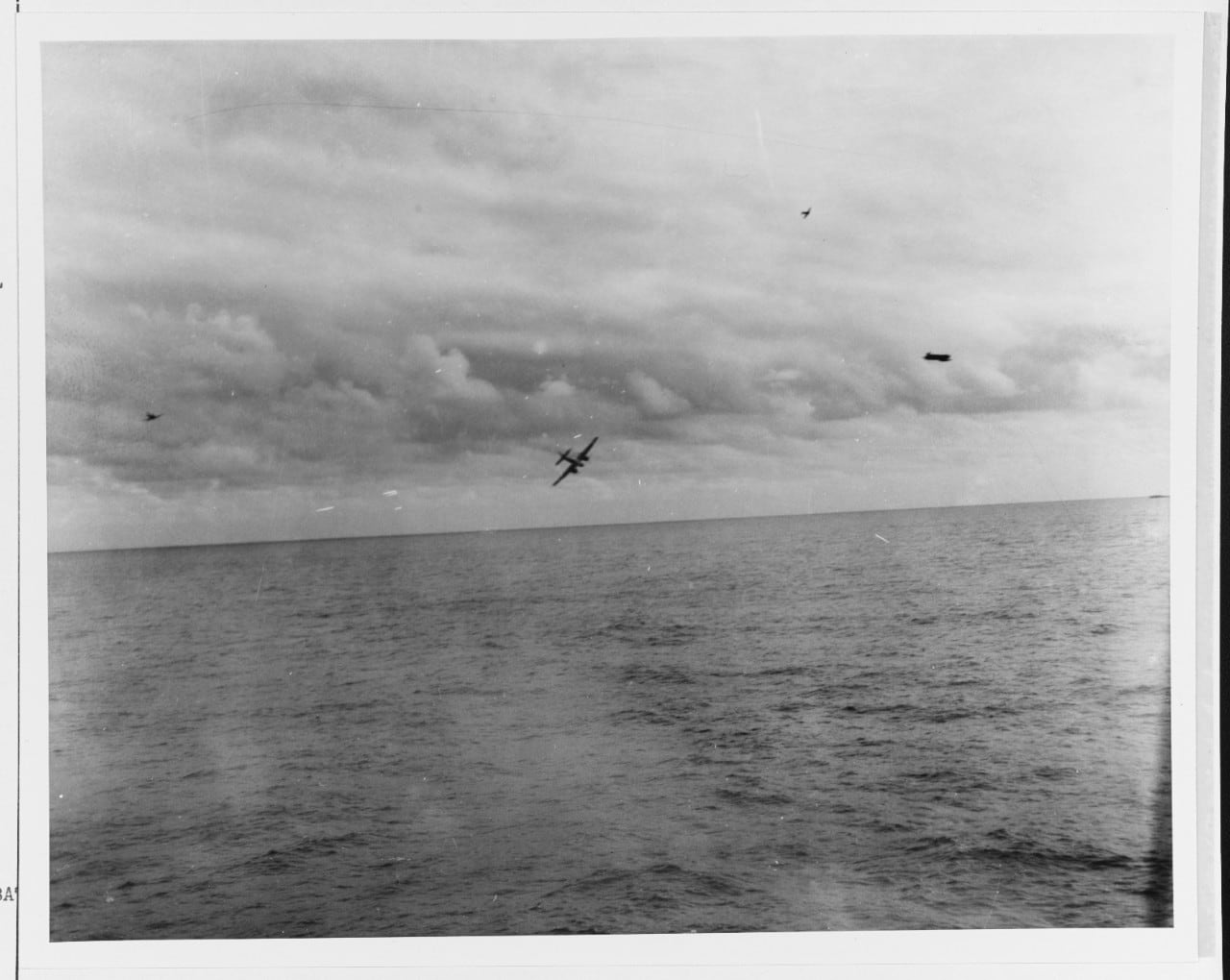
A 15th attacker — a bomb-toting Oscar — approached, with company: one of the dozen-plus Marine Corsairs and Navy Hellcats finally reaching RP 1.
Prey and pursuer zipped over gun boss Paul Smith’s basket, the Oscar shearing off the mast’s port yardarm — and with it the ship’s American flag — before hitting the water.
The Corsair clipped Laffey’s air search radar, toppling the “bedspring” antenna but gaining enough altitude for the pilot to bail out.
Crashing to Laffey’s signal deck, the big antenna just missed Kelly. Pumped with adrenaline, the New Jersey native, who had been a high school football star, briefly tried to haul the two-ton antenna clear while another signalman, Thomas McCarthy, climbed the mast stump to replace its battle ensign.
The friendly fighters were a godsend, but they did not end the Laffey’s troubles.
With a Corsair in chase, a Judy angled for the port beam. Before the ship’s gunners could lock on, the Judy crashed close by. Its bomb exploded, hurling metal through the thin side hatch of mount 52. The shrapnel knocked out an electrical panel and seriously wounded three gunners, including mount captain Warren G. Walker.
As other starboard 20s and 40s brought down a 17th attacker, Walker spotted an incoming plane low and far off the starboard beam. Men had to swivel the mount by hand. When the guns fired, Smith saw rounds splashing short.
He coaxed mount 52 pointer Seaman Kenneth Pitta, the 19-year-old son of Portuguese immigrants, to increase the range 50 yards — then watched a round strike home.
The plane “poised in space a few feet above the water” before disintegrating into “nothingness,” Becton recalled.
Below and forward of mount 52, mount 51 — also without power — slowly slewed toward a Val diving for the starboard bow. The pointer, gunner’s mate Welles Meier, 25, stomped his foot-pedal trigger, unleashing a salvo that also connected.
“We got him! We got him!” cried an exultant Andy Stash, 52’s trainer. “Good work, Welles!”
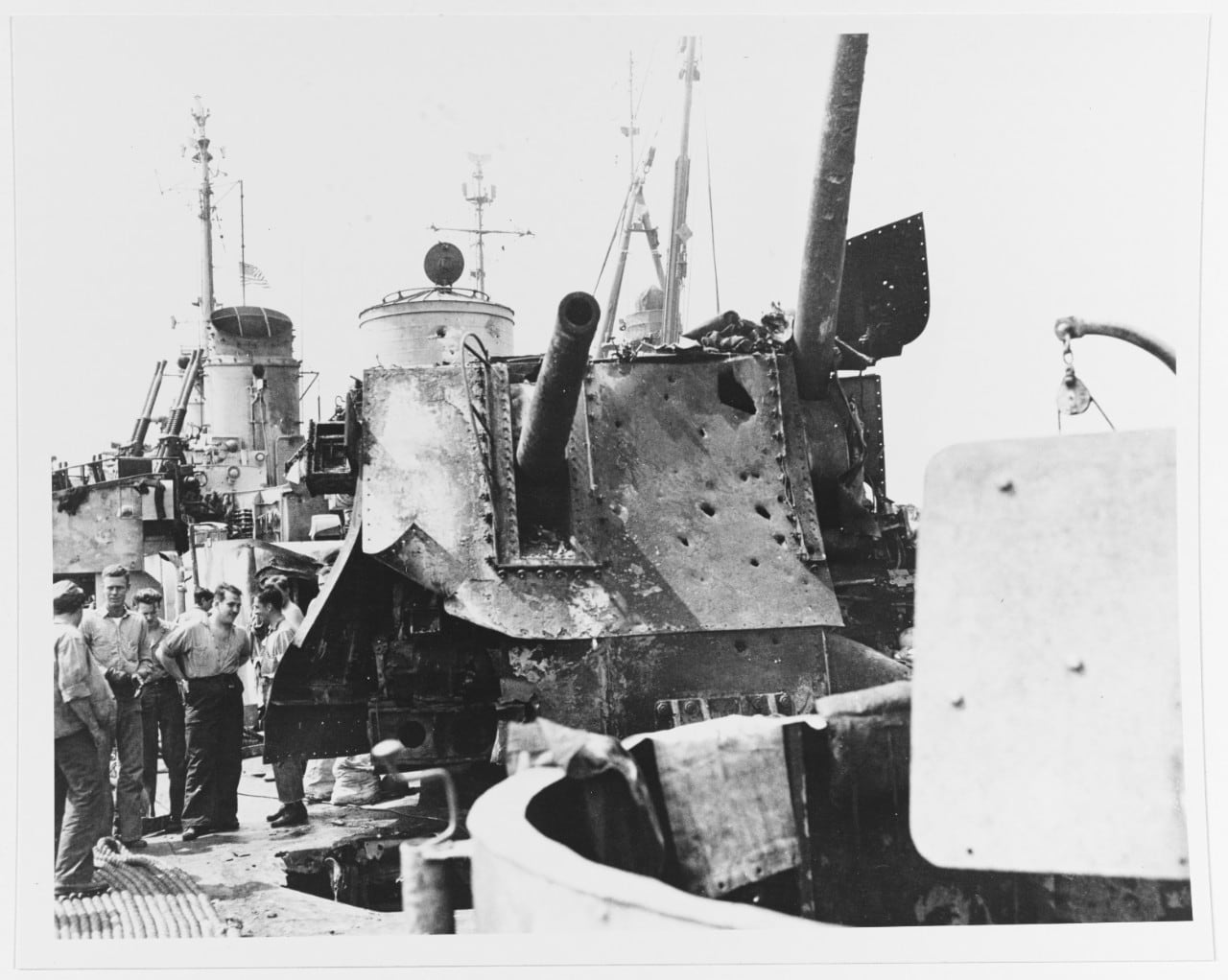
In the lull after these two remarkable gunnery feats, assistant communications officer Lt. Frank Manson asked Becton about abandoning ship.
No, the skipper insisted, not as long as one gun still fired.
Some, including Ari Phoutrides, were wondering if the ship would run out of gunners first.
Disastrous conditions aft only worsened when a 20th attacker, a Val concealed by sun and smoke, dropped a bomb on the fantail and flew off, carrying away the mast’s remaining yardarm. The bomb opened an 8-by-10-foot hole in the deck.
A Val dove in unopposed on the starboard bow; a strafing Judy on the port beam. Gunner’s mate Glenn Radder, 20, watched from the forecastle as the Val dropped a bomb into the starboard 20mm mount below the bridge.
The blast wiped out gun and crew and ripped a five-foot seam in the starboard bulkhead of the wardroom, crowded with medical personnel and wounded. The blast killed a pharmacist’s mate and the sailor he was treating. Shrapnel struck ship’s doctor Matthew Darnell’s hand but he kept working.
The Val and the Judy, attackers 21 and 22, met the same, nearly simultaneous fate: Okinawa-based Marine Corsairs shot down both planes.
After 80 minutes, the battle, arguably the most concentrated and relentless aerial suicide attack ever endured — and survived — by an American ship, had ended.
But the Laffey’s fight to survive went on.
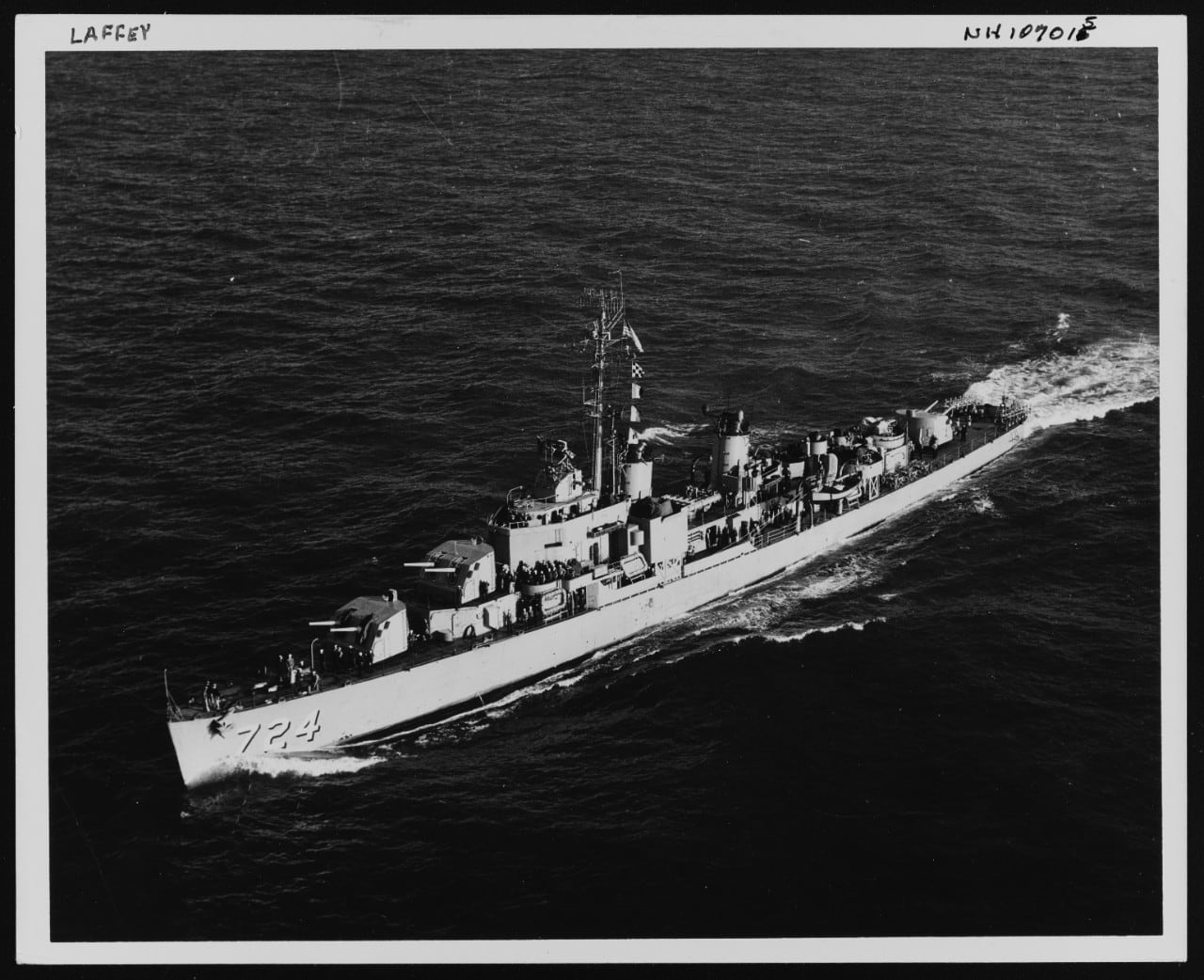
At 11 a.m., LCS-51, pumps primed, pulled the alongside the Laffey. The larger vessel’s condition astounded men on the gunboat. The destroyer was down by the stern; only two dogged-down hatches amidships were keeping it from flooding.
The high-speed minesweeper Macomb moved in to tow the Laffey until two tugs arrived. A tally revealed 103 casualties on the destroyer, including 32 dead.
LCS-116 had a dozen men killed and 12 more hurt. A rescue ship took the wounded for transfer to a hospital ship.
At four knots, the Laffey — on the verge of flooding — and its rescuers needed the balance of the day and night to reach anchorage off Okinawa.
Only seven days later, the hastily patched warship sailed to Saipan, then to Hawaii for more emergency work, and finally, on May 24, to the Todd Shipyard dry docks in Seattle, Washington.
Before repairs began, the Navy, to recruit shipyard workers and educate the public, opened the scarred vessel to visitors for two days.
Thousands came, many hearing the word “kamikaze” for the first time — and realizing what a lucky ship the Laffey truly was.
RELATED
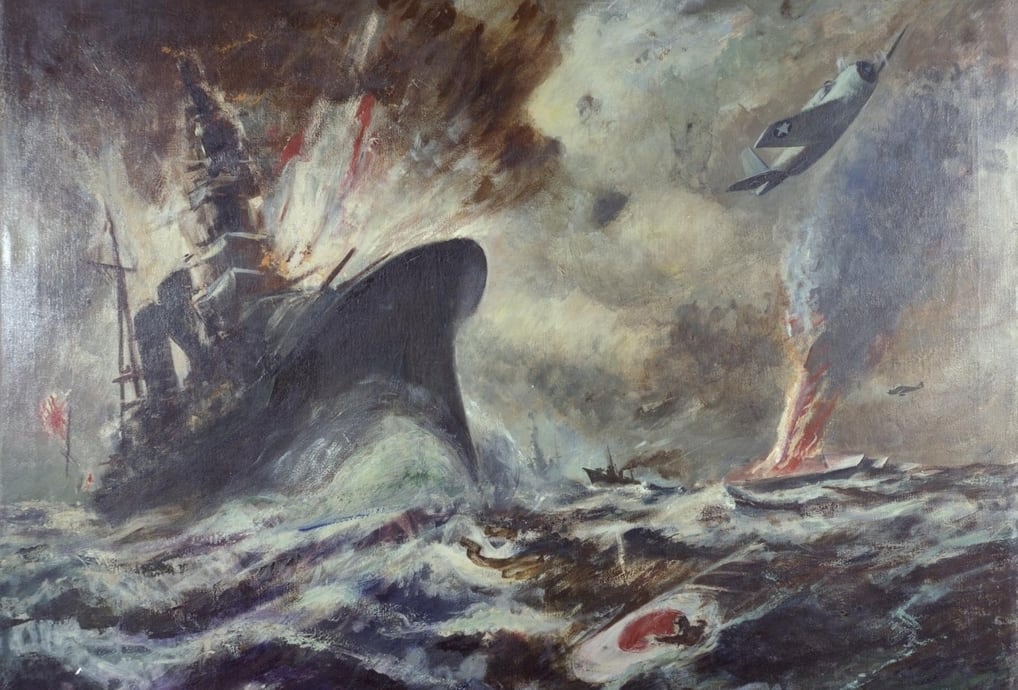
This article was originally published in the February 2015 issue of World War II, a sister publication to Navy Times. To subscribe, click here.




